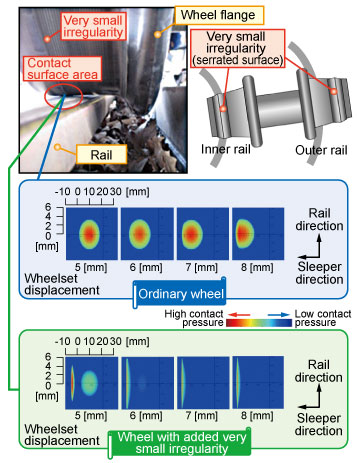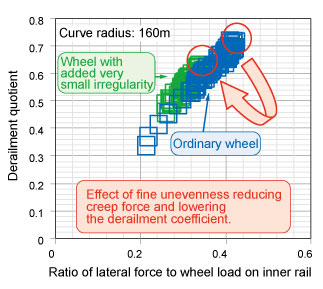10DMethod for reducing lateral force during curve negotiation by introducing fine unevenness to the wheel tread
- The influence of fine unevenness on the wheel tread on creep force characteristics was clarified.
- A method was proposed, and verified in tests at RTRI, for reducing lateral forces in curves by introducing a streak of fine unevenness on the outer tread circle of a wheel.
Fine unevenness may be left on the wheel tread (height of several Êm to several dozen Êm) due to reprofiling wear. This may cause the wheel/rail contact patch to lose its elliptical shape. It is thought that this influences creep force which may in turn affect vehicle dynamic characteristics.
In order to gain insight into the relationship between fine unevenness on the tread surface and creep force characteristics affecting the wheel/rail interface, an experiment to measure tangential forces was carried out using small test specimens of the tread surface and rail with differing height and pitch roughness. Results of these tests revealed that when the tread surface presented very fine roughness the wheel/rail contact area was in fact smaller and so the creep force was weaker than with a smooth tread surface; it was found that the lateral force in the sleeper direction in particular became smaller in the case of one specific kind of very fine roughness. A proposal was made, based on these findings, to reproduce this fine roughness on purpose on the outer tread circle of the wheel tread, as a method to reduce lateral force when running through a curve (Fig.1). It was demonstrated that this method reduces steady lateral force in curved sections by 10% compared to running with an ordinary smooth tread surface, which means that this procedure effectively increases the safety margin in relation to the strict requirements on wheel/rail coefficient of friction to prevent derailment (Fig.2).

Fig.1 Relationship between numerically calculated wheelset displacement and shape of contact surface on inner rail
Fig.2 Running test results showing effect
of reduced lateral force